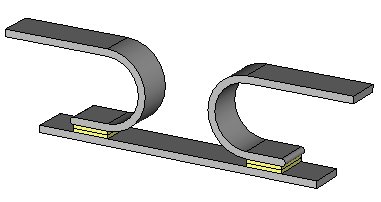


This example demonstrates the application of the stationary current solver for the analysis of a circuit breaker consisting of two contact springs connected by a bridge. A subject of interest is the current flow from one contact over the bridge to the other contact. If the current amplitude increases too much (e.g. caused by a short circuit) the bridge is pulled away from the springs - which is an effect caused by the current's magnetic field.
The contact springs will be constructed using the line and arc curve tools. The resulting curve can then be traced to form a solid. On either side of the contact area a gold pad is associated that can be constructed with the extrusion tool. For the construction of the bridge, a local coordinate system is employed to make creation of the brick easier.
The copper springs and the golden contact pads consist of highly conducting material. Two current ports are attached to the springs with potential value 0.05V and -0.05V. All boundary conditions are set to type tangential in order to prevent the current ports from being short-circuited. A tetrahedral mesh is used to discretize the model. The solver accuracy is set to 1e-6 for the stationary current solver to calculate the current flow and the electric field in the conductor.